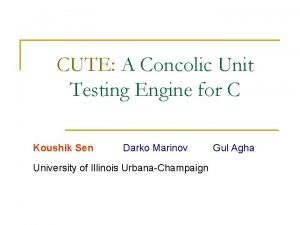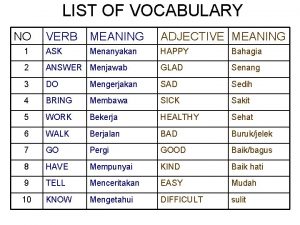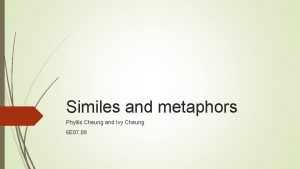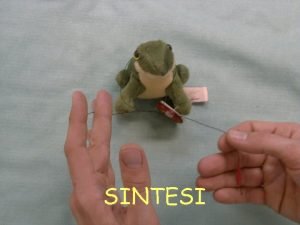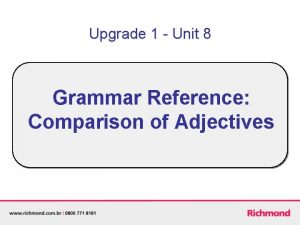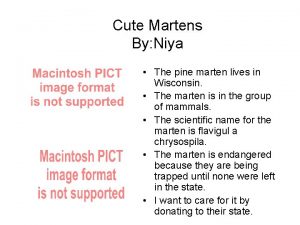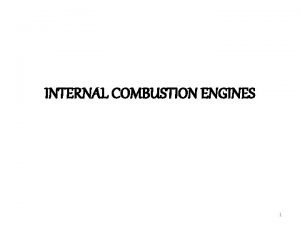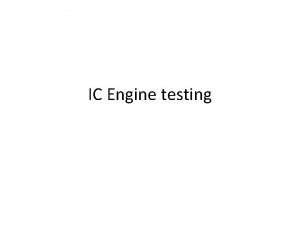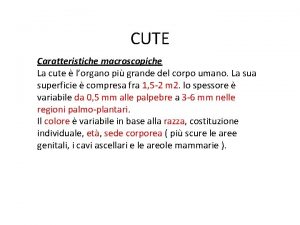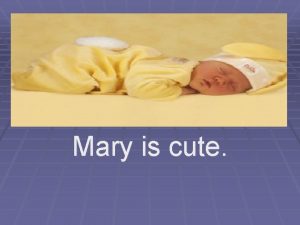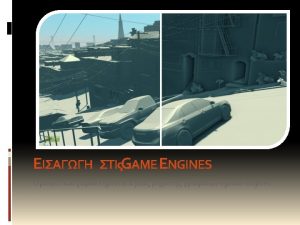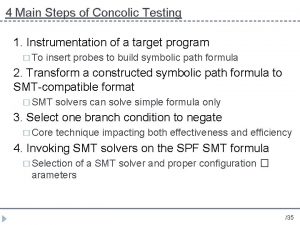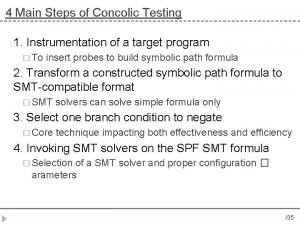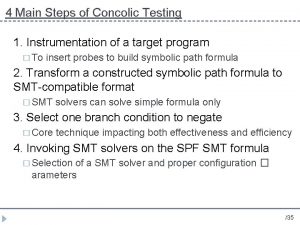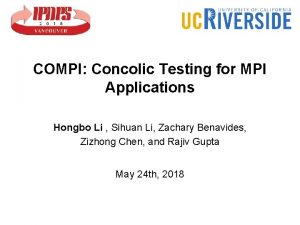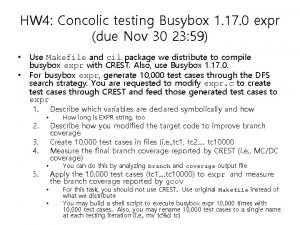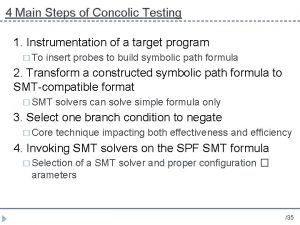CUTE A Concolic Unit Testing Engine for C































































- Slides: 63

CUTE: A Concolic Unit Testing Engine for C Koushik Sen Darko Marinov University of Illinois Urbana-Champaign Gul Agha

Goal n Automated Scalable Unit Testing of realworld C Programs q q Generate test inputs Execute unit under test on generated test inputs n q so that all reachable statements are executed Any assertion violation gets caught 2

Goal n Automated Scalable Unit Testing of realworld C Programs q q Generate test inputs Execute unit under test on generated test inputs n q n so that all reachable statements are executed Any assertion violation gets caught Our Approach: q Explore all execution paths of an Unit for all possible inputs n Exploring all execution paths ensure that all reachable statements are executed 3

Execution Paths of a Program n Can be seen as a binary tree with possibly infinite depth q n n n Computation tree Each node represents the execution of a “if then else” statement Each edge represents the execution of a sequence of non-conditional statements Each path in the tree represents an equivalence class of inputs 1 0 0 1 1 0 1 4

Example of Computation Tree void test_me(int x, int y) { if(2*x==y){ if(x != y+10){ printf(“I am fine here”); } else { printf(“I should not reach here”); ERROR; } } } N 2*x==y N Y x!=y+10 Y ERROR 5

Existing Approach I n Random testing q q n generate random inputs execute the program on generated inputs Probability of reaching an error can be astronomically less test_me(int x){ if(x==94389){ ERROR; } } Probability of hitting ERROR = 1/232 6

Existing Approach II n Symbolic Execution q q n use symbolic values for input variables execute the program symbolically on symbolic input values collect symbolic path constraints use theorem prover to check if a branch can be taken Does not scale for large programs test_me(int x){ if((x%10)*4!=17){ ERROR; } else { ERROR; } } Symbolic execution will say both branches are reachable: False positive 7

Approach n Combine concrete and symbolic execution for unit testing q n Concrete + Symbolic = Concolic In a nutshell q q Use concrete execution over a concrete input to guide symbolic execution Concrete execution helps Symbolic execution to simplify complex and unmanageable symbolic expressions n n by replacing symbolic values by concrete values Achieves Scalability q q Higher branch coverage than random testing No false positives or scalability issue like in symbolic execution based testing 8

Example typedef struct cell { int v; struct cell *next; } cell; int f(int v) { return 2*v + 1; } int testme(cell *p, int x) { if (x > 0) if (p != NULL) if (f(x) == p->v) if (p->next == p) abort(); return 0; } • Random Test Driver: • random memory graph reachable from p • random value for x • Probability of reaching abort( ) is extremely low 9

CUTE Approach Concrete Execution typedef struct cell { int v; struct cell *next; } cell; int f(int v) { return 2*v + 1; } int testme(cell *p, int x) { if (x > 0) if (p != NULL) if (f(x) == p->v) if (p->next == p) abort(); return 0; } concrete state Symbolic Execution symbolic state constraints p , x=236 NULL p=p 0, x=x 0 10

CUTE Approach Concrete Execution typedef struct cell { int v; struct cell *next; } cell; concrete state Symbolic Execution symbolic state constraints int f(int v) { return 2*v + 1; } int testme(cell *p, int x) { if (x > 0) if (p != NULL) if (f(x) == p->v) if (p->next == p) abort(); return 0; } p , x=236 NULL p=p 0, x=x 0 11

CUTE Approach Concrete Execution typedef struct cell { int v; struct cell *next; } cell; concrete state Symbolic Execution symbolic state constraints int f(int v) { return 2*v + 1; } int testme(cell *p, int x) { if (x > 0) if (p != NULL) if (f(x) == p->v) if (p->next == p) abort(); return 0; } x 0>0 p , x=236 NULL p=p 0, x=x 0 12

CUTE Approach Concrete Execution typedef struct cell { int v; struct cell *next; } cell; concrete state Symbolic Execution symbolic state constraints int f(int v) { return 2*v + 1; } int testme(cell *p, int x) { if (x > 0) if (p != NULL) if (f(x) == p->v) if (p->next == p) abort(); return 0; } x 0>0 !(p 0!=NULL) p , x=236 NULL p=p 0, x=x 0 13

CUTE Approach Concrete Execution typedef struct cell { int v; struct cell *next; } cell; concrete symbolic state solve: x 0>0 and p 0 NULL int f(int v) { return 2*v + 1; } int testme(cell *p, int x) { if (x > 0) if (p != NULL) if (f(x) == p->v) if (p->next == p) abort(); return 0; } Symbolic Execution constraints x 0>0 p 0=NULL p , x=236 NULL p=p 0, x=x 0 14

CUTE Approach Concrete Execution typedef struct cell { int v; struct cell *next; } cell; concrete symbolic state solve: x 0>0 and p 0 NULL int f(int v) { return 2*v + 1; } int testme(cell *p, int x) { if (x > 0) if (p != NULL) if (f(x) == p->v) if (p->next == p) abort(); return 0; } Symbolic Execution x 0=236, p 0 constraints NULL 634 x 0>0 p 0=NULL p , x=236 NULL p=p 0, x=x 0 15

CUTE Approach Concrete Execution typedef struct cell { int v; struct cell *next; } cell; int f(int v) { return 2*v + 1; } int testme(cell *p, int x) { if (x > 0) if (p != NULL) if (f(x) == p->v) if (p->next == p) abort(); return 0; } concrete state p 634 NULL , x=236 Symbolic Execution symbolic state constraints p=p 0, x=x 0, p->v =v 0, p->next=n 0 16

CUTE Approach Concrete Execution typedef struct cell { int v; struct cell *next; } cell; concrete state Symbolic Execution symbolic state constraints int f(int v) { return 2*v + 1; } int testme(cell *p, int x) { if (x > 0) if (p != NULL) if (f(x) == p->v) if (p->next == p) abort(); return 0; } p 634 NULL , x=236 p=p 0, x=x 0, p->v =v 0, p->next=n 0 x 0>0 17

CUTE Approach Concrete Execution typedef struct cell { int v; struct cell *next; } cell; concrete state Symbolic Execution symbolic state constraints int f(int v) { return 2*v + 1; } int testme(cell *p, int x) { if (x > 0) if (p != NULL) if (f(x) == p->v) if (p->next == p) abort(); return 0; } p 634 NULL , x=236 p=p 0, x=x 0, p->v =v 0, p->next=n 0 x 0>0 p 0 NULL 18

CUTE Approach Concrete Execution typedef struct cell { int v; struct cell *next; } cell; concrete state Symbolic Execution symbolic state constraints int f(int v) { return 2*v + 1; } int testme(cell *p, int x) { if (x > 0) if (p != NULL) if (f(x) == p->v) if (p->next == p) abort(); return 0; } p 634 NULL , x=236 p=p 0, x=x 0, p->v =v 0, p->next=n 0 x 0>0 p 0 NULL 2 x 0+1 v 0 19

CUTE Approach Concrete Execution typedef struct cell { int v; struct cell *next; } cell; concrete state Symbolic Execution symbolic state constraints int f(int v) { return 2*v + 1; } int testme(cell *p, int x) { if (x > 0) if (p != NULL) if (f(x) == p->v) if (p->next == p) abort(); return 0; } x 0>0 p 0 NULL 2 x 0+1 v 0 p 634 NULL , x=236 p=p 0, x=x 0, p->v =v 0, p->next=n 0 20

CUTE Approach Concrete Execution typedef struct cell { int v; struct cell *next; } cell; concrete symbolic state solve: x 0>0 and p 0 NULL and 2 x 0+1=v 0 int f(int v) { return 2*v + 1; } int testme(cell *p, int x) { if (x > 0) if (p != NULL) if (f(x) == p->v) if (p->next == p) abort(); return 0; } Symbolic Execution constraints x 0>0 p 0 NULL 2 x 0+1 v 0 p 634 NULL , x=236 p=p 0, x=x 0, p->v =v 0, p->next=n 0 21

CUTE Approach Concrete Execution typedef struct cell { int v; struct cell *next; } cell; concrete symbolic state solve: x 0>0 and p 0 NULL and 2 x 0+1=v 0 int f(int v) { return 2*v + 1; } int testme(cell *p, int x) { if (x > 0) if (p != NULL) if (f(x) == p->v) if (p->next == p) abort(); return 0; } Symbolic Execution x 0=1, p 0 constraints NULL 3 x 0>0 p 0 NULL 2 x 0+1 v 0 p 634 NULL , x=236 p=p 0, x=x 0, p->v =v 0, p->next=n 0 22

CUTE Approach Concrete Execution typedef struct cell { int v; struct cell *next; } cell; int f(int v) { return 2*v + 1; } int testme(cell *p, int x) { if (x > 0) if (p != NULL) if (f(x) == p->v) if (p->next == p) abort(); return 0; } p 3 Symbolic Execution concrete state symbolic state NULL , x=1 p=p 0, x=x 0, p->v =v 0, p->next=n 0 constraints 23

CUTE Approach Concrete Execution typedef struct cell { int v; struct cell *next; } cell; concrete state Symbolic Execution symbolic state constraints int f(int v) { return 2*v + 1; } int testme(cell *p, int x) { if (x > 0) if (p != NULL) if (f(x) == p->v) if (p->next == p) abort(); return 0; } p NULL , x=1 3 p=p 0, x=x 0, p->v =v 0, p->next=n 0 x 0>0 24

CUTE Approach Concrete Execution typedef struct cell { int v; struct cell *next; } cell; concrete state Symbolic Execution symbolic state constraints int f(int v) { return 2*v + 1; } int testme(cell *p, int x) { if (x > 0) if (p != NULL) if (f(x) == p->v) if (p->next == p) abort(); return 0; } p NULL , x=1 3 p=p 0, x=x 0, p->v =v 0, p->next=n 0 x 0>0 p 0 NULL 25

CUTE Approach Concrete Execution typedef struct cell { int v; struct cell *next; } cell; concrete state Symbolic Execution symbolic state constraints int f(int v) { return 2*v + 1; } int testme(cell *p, int x) { if (x > 0) if (p != NULL) if (f(x) == p->v) if (p->next == p) abort(); return 0; } p NULL , x=1 3 p=p 0, x=x 0, p->v =v 0, p->next=n 0 x 0>0 p 0 NULL 2 x 0+1=v 0 26

CUTE Approach Concrete Execution typedef struct cell { int v; struct cell *next; } cell; concrete state Symbolic Execution symbolic state constraints int f(int v) { return 2*v + 1; } int testme(cell *p, int x) { if (x > 0) if (p != NULL) if (f(x) == p->v) if (p->next == p) abort(); return 0; } x 0>0 p 0 NULL p NULL , x=1 3 p=p 0, x=x 0, p->v =v 0, p->next=n 0 2 x 0+1=v 0 n 0 p 0 27

CUTE Approach Concrete Execution typedef struct cell { int v; struct cell *next; } cell; concrete state Symbolic Execution symbolic state constraints int f(int v) { return 2*v + 1; } int testme(cell *p, int x) { if (x > 0) if (p != NULL) if (f(x) == p->v) if (p->next == p) abort(); return 0; } x 0>0 p 0 NULL p NULL , x=1 3 2 x 0+1=v 0 n 0 p=p 0, x=x 0, p->v =v 0, p->next=n 0 28

CUTE Approach Concrete Execution Symbolic Execution typedef struct cell { int v; struct cell *next; } cell; concrete state int f(int v) { return 2*v + 1; } solve: x 0>0 and p 0 NULL and 2 x 0+1=v 0 and n 0=p 0 int testme(cell *p, int x) { if (x > 0) if (p != NULL) if (f(x) == p->v) if (p->next == p) abort(); return 0; } symbolic state . p NULL , x=1 3 constraints x 0>0 p 0 NULL 2 x 0+1=v 0 n 0 p=p 0, x=x 0, p->v =v 0, p->next=n 0 29

CUTE Approach Concrete Execution Symbolic Execution typedef struct cell { int v; struct cell *next; } cell; concrete state int f(int v) { return 2*v + 1; } solve: x 0>0 and p 0 NULL and 2 x 0+1=v 0 and n 0=p 0 int testme(cell *p, int x) { if (x > 0) if (p != NULL) if (f(x) == p->v) if (p->next == p) abort(); return 0; } symbolic state x 0=1, p 0 3 p NULL , x=1 3 constraints x 0>0 p 0 NULL 2 x 0+1=v 0 n 0 p=p 0, x=x 0, p->v =v 0, p->next=n 0 30

CUTE Approach Concrete Execution typedef struct cell { int v; struct cell *next; } cell; int f(int v) { return 2*v + 1; } int testme(cell *p, int x) { if (x > 0) if (p != NULL) if (f(x) == p->v) if (p->next == p) abort(); return 0; } concrete state symbolic state , x=1 p=p 0, x=x 0, p->v =v 0, p->next=n 0 p 3 Symbolic Execution constraints 31

CUTE Approach Concrete Execution typedef struct cell { int v; struct cell *next; } cell; concrete state Symbolic Execution symbolic state constraints int f(int v) { return 2*v + 1; } int testme(cell *p, int x) { if (x > 0) if (p != NULL) if (f(x) == p->v) if (p->next == p) abort(); return 0; } p , x=1 3 p=p 0, x=x 0, p->v =v 0, p->next=n 0 x 0>0 32

CUTE Approach Concrete Execution typedef struct cell { int v; struct cell *next; } cell; concrete state Symbolic Execution symbolic state constraints int f(int v) { return 2*v + 1; } int testme(cell *p, int x) { if (x > 0) if (p != NULL) if (f(x) == p->v) if (p->next == p) abort(); return 0; } p , x=1 3 p=p 0, x=x 0, p->v =v 0, p->next=n 0 x 0>0 p 0 NULL 33

CUTE Approach Concrete Execution typedef struct cell { int v; struct cell *next; } cell; concrete state Symbolic Execution symbolic state constraints int f(int v) { return 2*v + 1; } int testme(cell *p, int x) { if (x > 0) if (p != NULL) if (f(x) == p->v) if (p->next == p) abort(); return 0; } p , x=1 3 p=p 0, x=x 0, p->v =v 0, p->next=n 0 x 0>0 p 0 NULL 2 x 0+1=v 0 34

CUTE Approach Concrete Execution typedef struct cell { int v; struct cell *next; } cell; concrete state Symbolic Execution symbolic state constraints int f(int v) { return 2*v + 1; } int testme(cell *p, int x) { if (x > 0) if (p != NULL) if (f(x) == p->v) if (p->next == p) abort(); return 0; } x 0>0 p 0 NULL Program Error p , x=1 3 p=p 0, x=x 0, p->v =v 0, p->next=n 0 2 x 0+1=v 0 n 0=p 0 35

Explicit Path (not State) Model Checking n Traverse all execution paths one by one to detect errors q q check for assertion violations check for program crash combine with valgrind to discover memory leaks detect invariants 1 0 0 1 1 0 1 37

Explicit Path (not State) Model Checking n Traverse all execution paths one by one to detect errors q q check for assertion violations check for program crash combine with valgrind to discover memory leaks detect invariants 1 0 0 1 1 0 1 38

Explicit Path (not State) Model Checking n Traverse all execution paths one by one to detect errors q q check for assertion violations check for program crash combine with valgrind to discover memory leaks detect invariants 1 0 0 1 1 0 1 39

Explicit Path (not State) Model Checking n Traverse all execution paths one by one to detect errors q q check for assertion violations check for program crash combine with valgrind to discover memory leaks detect invariants 1 0 0 1 1 0 1 40

Explicit Path (not State) Model Checking n Traverse all execution paths one by one to detect errors q q check for assertion violations check for program crash combine with valgrind to discover memory leaks detect invariants 1 0 0 1 1 0 1 41

Explicit Path (not State) Model Checking n Traverse all execution paths one by one to detect errors q q check for assertion violations check for program crash combine with valgrind to discover memory leaks detect invariants 1 0 0 1 1 0 1 42

Explicit Path (not State) Model Checking n Traverse all execution paths one by one to detect errors q q check for assertion violations check for program crash combine with valgrind to discover memory leaks detect invariants 1 0 0 1 1 0 1 43

Explicit Path (not State) Model Checking n Traverse all execution paths one by one to detect errors q q check for assertion violations check for program crash combine with valgrind to discover memory leaks detect invariants 1 0 0 1 1 0 1 44

CUTE in a Nutshell n Generate concrete inputs one by one q each input leads program along a different path 45

CUTE in a Nutshell n n Generate concrete inputs one by one q each input leads program along a different path On each input execute program both concretely and symbolically 46

CUTE in a Nutshell n n Generate concrete inputs one by one q each input leads program along a different path On each input execute program both concretely and symbolically q Both cooperate with each other n concrete execution guides the symbolic execution 47

CUTE in a Nutshell n n Generate concrete inputs one by one q each input leads program along a different path On each input execute program both concretely and symbolically q Both cooperate with each other n concrete execution guides the symbolic execution n concrete execution enables symbolic execution to overcome incompleteness of theorem prover q replace symbolic expressions by concrete values if symbolic expressions become complex q resolve aliases for pointer using concrete values q handle arrays naturally 48

CUTE in a Nutshell n n Generate concrete inputs one by one q each input leads program along a different path On each input execute program both concretely and symbolically q Both cooperate with each other n concrete execution guides the symbolic execution n concrete execution enables symbolic execution to overcome incompleteness of theorem prover q replace symbolic expressions by concrete values if symbolic expressions become complex q resolve aliases for pointer using concrete values q handle arrays naturally n symbolic execution helps to generate concrete input for next execution q increases coverage 49

Testing Data-structures of CUTE itself n Unit tested several non-standard datastructures implemented for the CUTE tool q q q n cu_depend (used to determine dependency during constraint solving using graph algorithm) cu_linear (linear symbolic expressions) cu_pointer (pointer symbolic expressions) Discovered a few memory leaks and a couple of segmentation faults q q these errors did not show up in other uses of CUTE for memory leaks we used CUTE in conjunction with Valgrind 50

SGLIB: popular library for C data-structures n n Used in Xrefactory a commercial tool for refactoring C/C++ programs Found two bugs in sglib 1. 0. 1 q q n reported them to authors fixed in sglib 1. 0. 2 Bug 1: q doubly-linked list library n n n segmentation fault occurs when a non-zero length list is concatenated with a zero-length list discovered in 140 iterations ( < 1 second) Bug 2: q hash-table n q an infinite loop in hash table is member function 193 iterations (1 second) 51

Simultaneous Symbolic & Concrete Execution void again_test_me(int x, int y){ z = x*x*x + 3*x*x + 9; if(z != y){ printf(“Good branch”); } else { printf(“Bad branch”); abort(); } } n Let initially x = -3 and y = 7 generated by random testdriver 52

Simultaneous Symbolic & Concrete Execution void again_test_me(int x, int y){ z = x*x*x + 3*x*x + 9; if(z != y){ printf(“Good branch”); } else { printf(“Bad branch”); abort(); } } n Let initially x = -3 and y = 7 generated by random testdriver n concrete z = 9 symbolic z = x*x*x + 3*x*x+9 n n take then branch with constraint x*x*x+ 3*x*x+9 != y 53

Simultaneous Symbolic & Concrete Execution void again_test_me(int x, int y){ z = x*x*x + 3*x*x + 9; if(z != y){ printf(“Good branch”); } else { printf(“Bad branch”); abort(); } } n Let initially x = -3 and y = 7 generated by random testdriver n concrete z = 9 symbolic z = x*x*x + 3*x*x+9 n n take then branch with constraint x*x*x+ 3*x*x+9 != y solve x*x*x+ 3*x*x+9 = y to take else branch Don’t know how to solve !! q Stuck ? 54

Simultaneous Symbolic & Concrete Execution void again_test_me(int x, int y){ z = x*x*x + 3*x*x + 9; if(z != y){ printf(“Good branch”); } else { printf(“Bad branch”); abort(); } } n Let initially x = -3 and y = 7 generated by random testdriver n concrete z = 9 symbolic z = x*x*x + 3*x*x+9 n n take then branch with constraint x*x*x+ 3*x*x+9 != y solve x*x*x+ 3*x*x+9 = y to take else branch Don’t know how to solve !! q Stuck ? q NO : CUTE handles this smartly 55

Simultaneous Symbolic & Concrete Execution void again_test_me(int x, int y){ z = x*x*x + 3*x*x + 9; if(z != y){ printf(“Good branch”); } else { printf(“Bad branch”); abort(); } } n Let initially x = -3 and y = 7 generated by random testdriver 56

Simultaneous Symbolic & Concrete Execution void again_test_me(int x, int y){ z = x*x*x + 3*x*x + 9; if(z != y){ printf(“Good branch”); } else { printf(“Bad branch”); abort(); } } n Let initially x = -3 and y = 7 generated by random testdriver n concrete z = 9 symbolic z = x*x*x + 3*x*x+9 q cannot handle symbolic value of z n 57

Simultaneous Symbolic & Concrete Execution void again_test_me(int x, int y){ z = x*x*x + 3*x*x + 9; if(z != y){ printf(“Good branch”); } else { printf(“Bad branch”); abort(); } } n Let initially x = -3 and y = 7 generated by random testdriver n concrete z = 9 symbolic z = x*x*x + 3*x*x+9 q cannot handle symbolic value of z q make symbolic z = 9 and proceed n 58

Simultaneous Symbolic & Concrete Execution void again_test_me(int x, int y){ z = x*x*x + 3*x*x + 9; if(z != y){ printf(“Good branch”); } else { printf(“Bad branch”); abort(); } } n Let initially x = -3 and y = 7 generated by random testdriver n concrete z = 9 symbolic z = x*x*x + 3*x*x+9 q cannot handle symbolic value of z q make symbolic z = 9 and proceed n n take then branch with constraint 9 != y 59

Simultaneous Symbolic & Concrete Execution void again_test_me(int x, int y){ z = x*x*x + 3*x*x + 9; if(z != y){ printf(“Good branch”); } else { printf(“Bad branch”); abort(); } } n Let initially x = -3 and y = 7 generated by random testdriver n concrete z = 9 symbolic z = x*x*x + 3*x*x+9 q cannot handle symbolic value of z q make symbolic z = 9 and proceed n n take then branch with constraint 9 != y solve 9 = y to take else branch execute next run with x = -3 and y= 9 q got error (reaches abort) 60

Simultaneous Symbolic & Concrete Execution void again_test_me(int x, int y){ z = x*x*x + 3*x*x + 9; if(z != y){ printf(“Good branch”); } else { printf(“Bad branch”); abort(); } Replace symbolic expression by } concrete value when symbolic expression becomes unmanageable (i. e. non-linear) n Let initially x = -3 and y = 7 generated by random testdriver n concrete z = 9 symbolic z = x*x*x + 3*x*x+9 q cannot handle symbolic value of z q make symbolic z = 9 and proceed n n take then branch with constraint 9 != y solve 9 = y to take else branch execute next run with x = -3 and y= 9 q got error (reaches abort) 61

Simultaneous Symbolic & Concrete Execution void again_test_me(int x, int y){ z = x*x*x + 3*x*x + 9; if(z != y){ printf(“Good branch”); } else { printf(“Bad branch”); abort(); } } void again_test_me(int x, int y){ z = black_box_fun(x); if(z != y){ printf(“Good branch”); } else { printf(“Bad branch”); abort(); } } 62

Related Work n “DART: Directed Automated Random Testing” by Patrice Godefroid, Nils Klarlund, and Koushik Sen (PLDI’ 05) q n handles only arithmetic constraints CUTE q Supports C with n q Highly efficient constraint solver n q q q pointers, data-structures 100 -1000 times faster arithmetic, pointers Provides Bounded Depth-First Search and Random Search strategies Publicly available tool that works on ALL C programs 63

Discussion n CUTE is q light-weight q dynamic analysis (compare with static analysis) n q concrete execution and symbolic execution run simultaneously n q n n symbolic execution consults concrete execution whenever dynamic analysis becomes intractable real tool that works on all C programs n n ensures no false alarms completely automatic Requires actual code that can be fully compiled Can sometime reduce to Random Testing Complementary to Static Analysis Tools 64
 Cute: a concolic unit testing engine for c
Cute: a concolic unit testing engine for c Functional testing vs unit testing
Functional testing vs unit testing My cute one
My cute one Monkey life cycle
Monkey life cycle Finish verb 3
Finish verb 3 Life cycle of a
Life cycle of a As cute as a kitten simile
As cute as a kitten simile She look cute
She look cute 666 nnn
666 nnn Lion writing
Lion writing Flat adverbs examples
Flat adverbs examples Sleeping pig
Sleeping pig Cute pronouns
Cute pronouns How to remember reactivity series
How to remember reactivity series He looks cute
He looks cute O vicryl suture
O vicryl suture Cute superlative
Cute superlative Pdf cute
Pdf cute Cute pine marten
Cute pine marten External and internal combustion engine
External and internal combustion engine Volumetric efficiency of engine
Volumetric efficiency of engine Motoring test is used to measure
Motoring test is used to measure Unit 10, unit 10 review tests, unit 10 general test
Unit 10, unit 10 review tests, unit 10 general test Domain testing in software testing
Domain testing in software testing Motivational overview of logic based testing
Motivational overview of logic based testing Du path testing
Du path testing Positive vs negative testing
Positive vs negative testing Cs 3250
Cs 3250 Localization globalization testing
Localization globalization testing Language testing
Language testing Control structure testing in software testing
Control structure testing in software testing Decision table testing in software testing
Decision table testing in software testing Decision table testing example
Decision table testing example Pengertian black box testing
Pengertian black box testing Behavior testing adalah
Behavior testing adalah Decision table based testing in software testing
Decision table based testing in software testing Rigorous testing in software testing
Rigorous testing in software testing Testing blindness in software testing
Testing blindness in software testing Component testing is a black box testing
Component testing is a black box testing Software domain examples
Software domain examples Formuö
Formuö Novell typiska drag
Novell typiska drag Tack för att ni lyssnade bild
Tack för att ni lyssnade bild Ekologiskt fotavtryck
Ekologiskt fotavtryck Varför kallas perioden 1918-1939 för mellankrigstiden
Varför kallas perioden 1918-1939 för mellankrigstiden En lathund för arbete med kontinuitetshantering
En lathund för arbete med kontinuitetshantering Adressändring ideell förening
Adressändring ideell förening Personlig tidbok
Personlig tidbok Sura för anatom
Sura för anatom Förklara densitet för barn
Förklara densitet för barn Datorkunskap för nybörjare
Datorkunskap för nybörjare Tack för att ni lyssnade bild
Tack för att ni lyssnade bild Tes debattartikel
Tes debattartikel Delegerande ledarskap
Delegerande ledarskap Nyckelkompetenser för livslångt lärande
Nyckelkompetenser för livslångt lärande Påbyggnader för flakfordon
Påbyggnader för flakfordon Formel för lufttryck
Formel för lufttryck Offentlig förvaltning
Offentlig förvaltning Jag har nigit för nymånens skära
Jag har nigit för nymånens skära Presentera för publik crossboss
Presentera för publik crossboss Jiddisch
Jiddisch Kanaans land
Kanaans land Treserva lathund
Treserva lathund Luftstrupen för medicinare
Luftstrupen för medicinare
